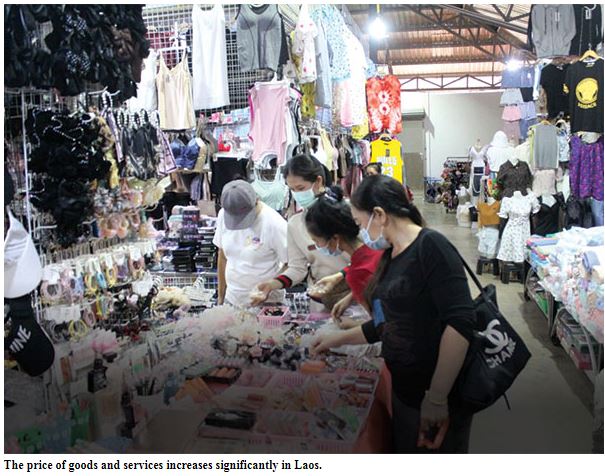Inflation forcing Asian nations to tighten monetary policies
High inflation pressures in many Asian countries including Laos are driving central banks to tighten monetary policy more quickly than expected, according to a new report by the Asian Development Bank (ADB).
The Asian Economic Integration Report 2023 stated that tightening monetary policies to contain inflationary pressures in many advanced economies are affecting external demand and do not bode well for the region’s exports.
“Inflation rose to higher levels in most Asian economies in the second quarter (Q2) or Q3 of 2022, compared with 2021 and 2020, especially in Azerbaijan, Laos, Pakistan and Sri Lanka,” the ADB report said.
Laos has one of the highest inflation rates in Asia, with many low-income earners struggling to afford basic necessities.
In February this year, the year-on-year inflation rate soared to 41.3 percent, up from 40.3 percent in January, according to the Lao Statistics Bureau.
The price rise was driven by hikes in the food and non-alcoholic beverage category which soared by 49.3 percent, followed by the communications and transport category (47.4 percent), medical care and medicines (42.4 percent), hotel and restaurant category (36.2 percent), and household goods (35.4 percent).
Khammuan province reported the highest inflation rate at 49.82 percent, followed by Vientiane province (47.18 percent), Luang Prabang province (45.09 percent), Oudomxay province (44.62 percent) and Huaphan province (42.94 percent).
According to the ADB, policy rate hikes across the world to rein in surging inflation, exacerbated by the escalation of geopolitical tensions, provide another drag.
In light of the buildup of headwinds, the Asian Development Outlook 2022 Supplement in December pared the growth forecast for developing Asia to 4.2 percent in 2022 and 4.6 percent in 2023.
Nevertheless, recent trends point to growing inflation pressures on regional economies as price pressures spread across broader economies from commodities to agriculture, manufacturing, and services.
Excessive inflation due to rising food prices was exacerbated by rising oil and gas prices at the onset of the Russian-Ukraine conflict.
The US Federal Reserve Bank (the Fed) began raising the federal funds rate in March 2022, the first time it has done so since December 2018.
The currencies of the economies of South Asia, Southeast Asia, and East Asia generally weakened, while those of Central Asia and the Pacific and Oceania strengthened. Currency depreciations were highest in Sri Lanka and Laos since January 2022.
Laos has huge potential to boost trade with other countries through the Laos-China railway, which links the Lao capital Vientiane to Kunming in southern China.
In January and February the railway carried a total of 417,400 passengers, an increase of 256.2 percent compared to the same period last year. The railway also transported 647,700 tons of goods in these two months, an increase of 320 percent compared to the same period last year.
The Laos-China railway is part of the bigger Kunming-Singapore railway or Pan-Asia rail network, which is a network of railways connecting China and all contiguous Southeast Asia.
Besides the traditional manufacturing powerhouses, many developing economies in the region such as Laos, Cambodia and Vietnam are increasing their participation in global value chains.
Source: https://www.vientianetimes.org.la/freeContent/FreeConten2023_Inflation48.php


 Thailand
Thailand




